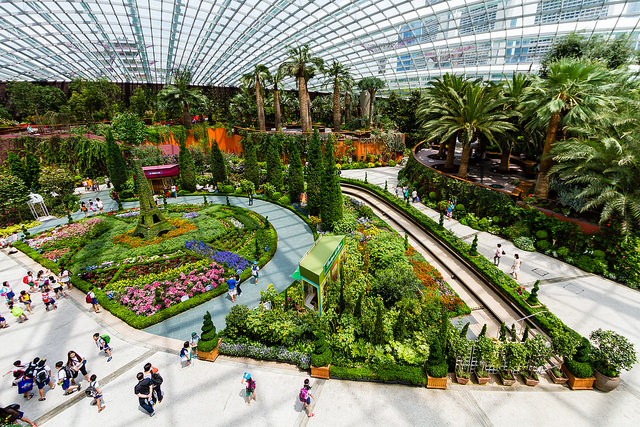When meltwater breached the global seed bank near Svalbard in May, after unusually warm weather, it served as a stark reminder of the need to safeguard humanity’s future in the face of increasing turbulence.
Buried 130 metres deep inside a mountain, the vault was designed to protect the world’s most precious seeds from disaster, to ensure the future of the global food supply. This secure, carefully configured indoor space for threatened ecologies has now, itself, been threatened by the ecological transformation and degradation produced outside by climate change.
Yet for some, the solution is not to continue trying to save the “outside”, but to rework and intensify previous efforts to make new outsides – inside. More and more attempts are being made to create new synthetic environments, which reproduce an artificial “outside” within enclosed membranes.
These controlled environments are seen as a way to overcome the constraints and uncertainties of an increasingly turbulent and unstable outside world. Artificial, synthetic and hybrid ecologies, some of which bear no resemblance to the natural world, are becoming a major feature in urban landscapes across the globe. Efficient, technologically controlled “designer” environments are rebundled and repackaged for food production, plant and animal conservation – and even human occupation.

Urban farming in action. Demipoulpe/Flickr, CC BY-NC-ND
For example, synthetic environments are being configured as spaces for the production of food, crops and plants as rainfall and temperature changes due to climate change cast uncertainty over future agricultural productivity. “Precision” food production is taking place under technologically controlled “inside” environments, where temperature, humidity, water and light are managed and tailored to facilitate optimal conditions for food production, and alleviate the problems of risky and unsustainable “outside” growing environments.
Vertical farming has taken off in a number of US cities using hydroponic or aeroponic techniques, which require less water and soil than normal farming. Bespoke algorithms and sensing devices ensure growing conditions are tailored and monitored for particular crops – and grow boxes are stacked high to produce crops in dense and confined urban spaces. Disused air raid shelters in London and shipping containers in Boston are being appropriated for salad leaf and herb production. And Ikea now sells a full range of indoor gardening kits for apartment dwellers who do not have access to outside space.
Safe haven
Synthetic environments are also being configured as protected spaces for species under threat from a more turbulent climate. Gardens by the Bay, sitting on a 100-hectare site near the commercial centre of Singapore, provides an important example of a protected environment for plant ecologies – it was explicitly designed by the state to exemplify the 21st-century garden city.
The gardens contain thousands of carefully selected plants, most of which wouldn’t be able to survive in Singapore’s natural climate. They are contained within two massive air-conditioned glasshouses, supported by a complex technical infrastructure. One is designed to replicate a cool-dry Mediterranean climate, while in the other, an artificial cloud forest contains a man-made waterfall, planted with species rated as having “high conservation value” from tropical mountain climates around the world.

A whole new world. thebeautyofpeace/Flickr, CC BY-NC
Here, ecological conservation converges with tourism, as part of a strategic state project to demonstrate Singapore’s ability to control climate. Indeed, the strategic ability to configure new synthetic environments may be becoming a crucial means for governments at all levels to attempt to deal with a economic and ecological uncertainties. The critical issue is whether these forms of enclosures seek to ensure the protection of premium users and the wealthiest cities, while vulnerable and ordinary cities are left to cope with more uncertain and turbulent conditions outside.
Exclusive environments
Governments and companies are also creating synthetic environments as spaces for consumption. Artificial “natures” are created inside to reproduce, and improve on, the kinds of environments where particular sports and leisure activities can take place. New forms of enclosed, highly engineered interiors can be seen in the expansion of indoor ski slopes, climbing centres and artificial sports pitches. Some premium hotels and apartments now incorporate snow caves, jungle showers and virtual golf courses.
Shopping and leisure activities now come with an environmental experience, in new enclosures designed to allow wealthy consumers to escape from the hostile environment outside. Consider, for example, Khan Shatyr SEC in Astana, Kazakhstan – billed as “the biggest tent in the world”. Or Dubai’s Mall of the World, or the Tropical Islands resort outside Berlin – which recreates Asian villages, beaches and an indoor rainforest within the largest free-standing dome in the world.

The inside of Khan Shatyr, Kazakhstan. ninara/Flickr, CC BY
The new logic here is to create improved, processed, extracted and intensified environments. These are not simulations or recreations – they are new designer environments in their own right: specialised, productive, desirable and (it is claimed) safe and secure.
Yet the development of these new spaces requires a complex, bespoke infrastructure usually including air conditioning, water treatment, waste processing, heating and cooling and the manipulation of air pressure, as well as incorporating digital technologies and devices. As such, they are very expensive and require vast amounts of energy and resources to produce and maintain. In this way, those investing in synthetic environments actually contribute to the degradation of the outside world, while aiming to create comfortable and secure inside worlds.
Creating new outsides, inside, poses new contradictions graphically illustrated by the flooding of the Svalbard seed bank. Attempts to enclose and secure environments can produce new and unintended vulnerabilities, such as ecological change and technological failures. In this moment, it is critical to pause and consider whether it would not make more sense to develop more collective and global solutions to improve the world outside, rather than continuing on the path to create contained, climate-controlled ecologies inside.
 The authors do not work for, consult, own shares in or receive funding from any company or organisation that would benefit from this article, and have disclosed no relevant affiliations beyond the academic appointment above.
The authors do not work for, consult, own shares in or receive funding from any company or organisation that would benefit from this article, and have disclosed no relevant affiliations beyond the academic appointment above.



 The UK is surprisingly short of water – but more reservoirs aren’t the answer
The UK is surprisingly short of water – but more reservoirs aren’t the answer  Parasites are ecological dark matter – and they need protecting
Parasites are ecological dark matter – and they need protecting  What’s so special about Ukraine’s minerals? A geologist explains
What’s so special about Ukraine’s minerals? A geologist explains  We combed through old botanical surveys to track how plants on Australia’s islands are changing
We combed through old botanical surveys to track how plants on Australia’s islands are changing  GesiaPlatform Launches Carbon-Neutral Lifestyle App ‘Net Zero Heroes’
GesiaPlatform Launches Carbon-Neutral Lifestyle App ‘Net Zero Heroes’  LA fires: Long-term exposure to wildfire smoke is poorly understood − and a growing risk
LA fires: Long-term exposure to wildfire smoke is poorly understood − and a growing risk  As the Black Summer megafires neared, people rallied to save wildlife and domestic animals. But it came at a real cost
As the Black Summer megafires neared, people rallied to save wildlife and domestic animals. But it came at a real cost  Drug pollution in water is making salmon take more risks – new research
Drug pollution in water is making salmon take more risks – new research  Fertile land for growing vegetables is at risk — but a scientific discovery could turn the tide
Fertile land for growing vegetables is at risk — but a scientific discovery could turn the tide  Ukraine minerals deal: the idea that natural resource extraction can build peace has been around for decades
Ukraine minerals deal: the idea that natural resource extraction can build peace has been around for decades  Burkina Faso and Mali’s fabulous flora: new plant life record released
Burkina Faso and Mali’s fabulous flora: new plant life record released  Rise of the Zombie Bugs takes readers on a jaw-dropping tour of the parasite world
Rise of the Zombie Bugs takes readers on a jaw-dropping tour of the parasite world 

































